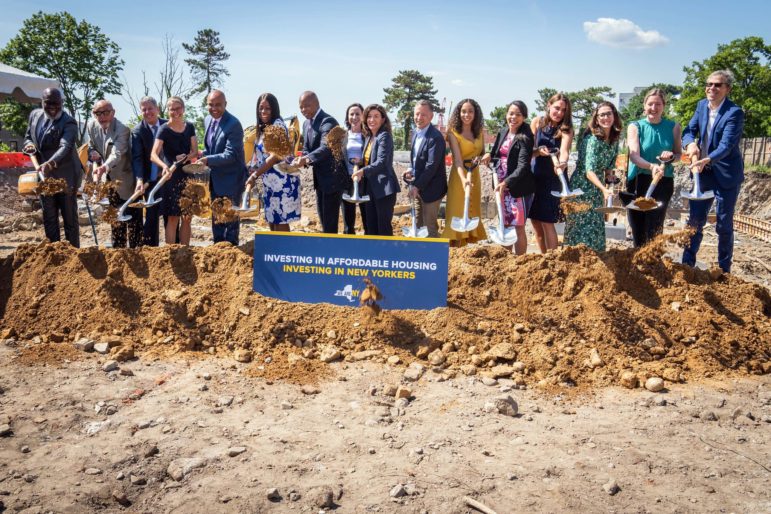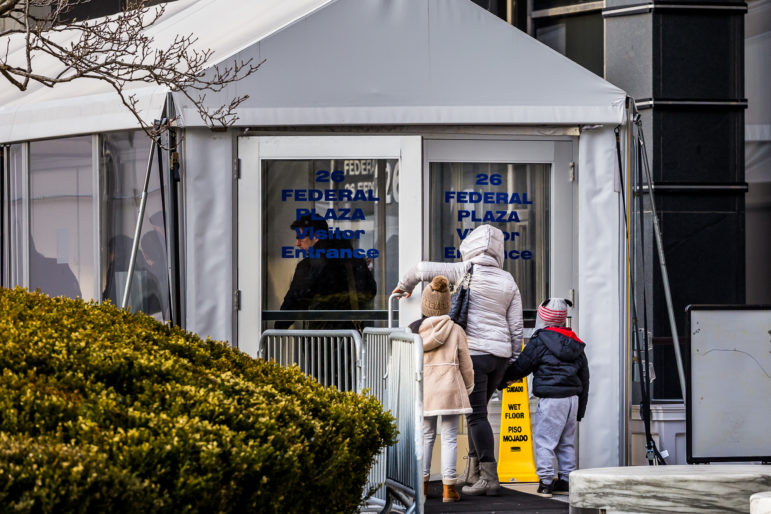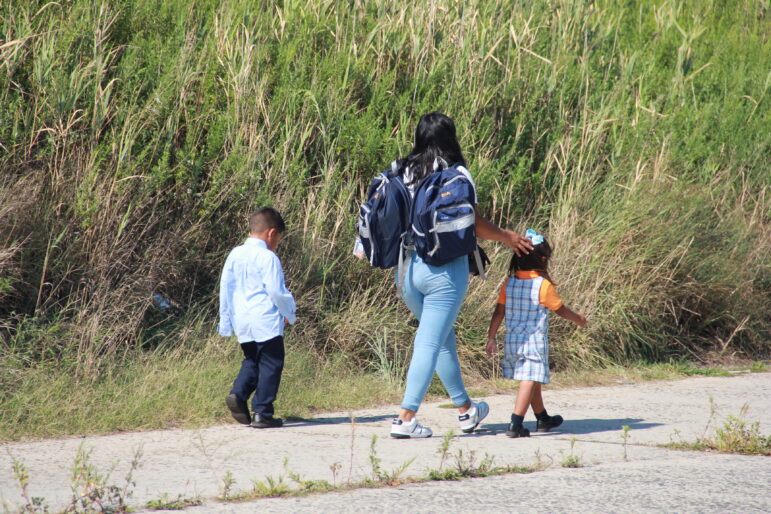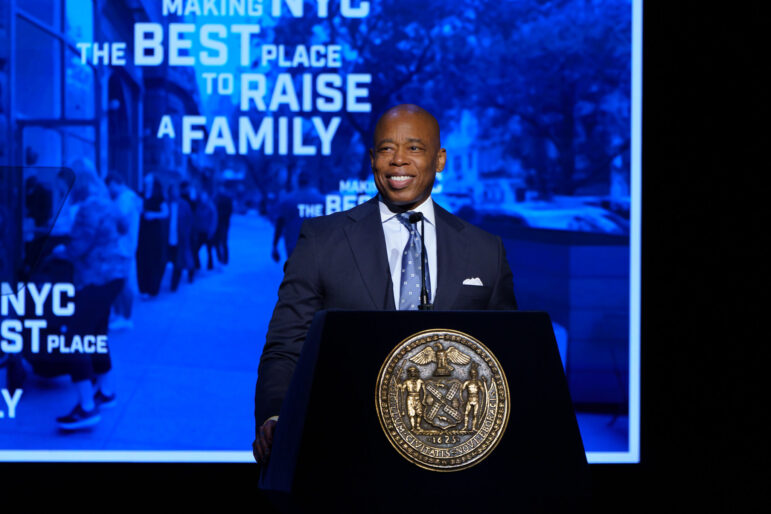During the most recent fiscal year, just 16 percent of New Yorkers approved by the city for supportive housing were actually placed with an apartment. More than half of the 7,426 eligible applicants during that time were never even referred for an interview, according to data recently published by the city’s Department of Social Services (DSS).

Ed Reed/Mayoral Photography Office.
“Nothing does it better than supportive housing,” Mayor Adams said at the groundbreaking ceremony for a $189 million development in the Morris Heights section of the Bronx on July 27, 2022.Last month, at the groundbreaking ceremony for an affordable apartment complex in The Bronx, Mayor Eric Adams praised the project as a model for the type of housing he sees as key to solving the city’s homelessness crisis.
Supportive housing—affordable apartments paired with support services for vulnerable tenants, such as counseling and health care referrals—is “where our money should go,” the mayor said. “We know that permanent housing can transform lives,” Adams said. “Nothing does it better than supportive housing.”
But landing a supportive unit in New York City is tough, even for tenants who qualify. During the most recent fiscal year from June 2021 to the end of July, just 16 percent of New Yorkers approved by the city for supportive housing were actually placed in an apartment. More than half of the 7,426 eligible applicants during that time were never even referred for an interview, according to data recently published by the city’s Department of Social Services (DSS).
The odds can be even stiffer for tenants with the greatest needs, advocates have long charged. Though supportive housing is intended for people dealing with mental illness, substance use disorders and other challenges, more than 250 applicants last fiscal year were turned down after an interview with a supportive housing provider because their “level of service needed” was greater than what the program could offer, the most common reason for such a rejection, the DSS data shows.
And of the 1,224 applicants who were successfully accepted into supportive housing last fiscal year, just 16 were street homeless at the time—a strikingly small number, advocates say, during a time when the Adams administration and NYPD have been aggressively removing unsheltered New Yorkers from public spaces.
“I think that speaks to the challenges that some of the most vulnerable people face in navigating this very complicated supportive housing eligibility and placement process,” said Jacquelyn Simone, policy director at Coalition for the Homeless, which runs its own supportive housing units and also helps clients navigate the application process.
A large part of the problem is supply and demand: While the mayor has pledged to build 15,000 new supportive apartments by 2030, more than 90 percent of the city’s current supportive housing stock is already occupied. There were just 1,500 vacancies in July, down from around 2,500 vacant units earlier this year—what city officials say indicates progress in its efforts to speed up placements, which slowed during the pandemic.
In addition to availability, supportive housing providers say they’re hampered by outdated government contracts that pay too little to cover the costs of offering comprehensive services, as well as by gaps in the wider health care system and social safety net.
“In a perfect world, supportive housing, which is not designed or funded to provide medical or psychiatric services, would be one intervention on a continuum of housing and support options and would be buttressed by robust services in the community,” Maclain Berhaupt, interim executive director of the Supportive Housing Network of New York (SHNNY), which represents about 200 providers across the state, said in a statement. “However, supportive housing has become the only option, and the funding has not kept up with the level of need.”
Advocates and tenants, however, say the supportive housing placement process is stacked against tenants, particularly the most vulnerable, who must complete a complicated application and interview process for a long-shot chance at an apartment.
“Supportive housing landlords and providers act with virtual impunity whenever they decide to deny an applicant access to housing,” Supportive Housing Organized and United Tenants (SHOUT), a group made up of supportive housing residents, said in a statement. “The supportive housing system must work for those who face the most obstacles to accessing housing. Right now, it does not do that, and that is the challenge we all must confront.”
By the numbers
Until recently, the city did not publicly release details on supportive housing acceptance and rejections, forcing advocates at Urban Justice Center’s Safety Net Project to file Freedom of Information Law requests to access that data (the organization did so for years, sharing the findings on Twitter).
But last year the City Council passed a bill requiring DSS to publish an annual report on its Coordinated Assessment and Placement System, known as CAPS, which tracks data on applicants and placement decisions across 27,000 supportive apartments in the five boroughs.
The bill was intended to help identify trends and discriminatory practices such as “creaming”—when, advocates allege, providers screen specifically for applicants who require the least extensive services, choosing them over applicants with greater needs. Supportive housing providers, unsurprisingly, opposed the legislation, which languished for four years before finally passing the Council last December.
DSS published the first required report under the new Local Law 3 last week, which revealed that of the 7,426 supportive housing applicants last fiscal year—which included 6,913 individuals and 513 families—fewer than half were referred to housing providers for an interview, and just 1,224 were ultimately approved for housing. (That number, DSS points out, does not include clients who were placed in apartments during the reporting period but who had their applications approved prior to the start of Fiscal Year 2021. It also did not include the placement outcomes for approximately 1,400 people referred during the final two months of the reporting period, DSS notes).
“While the LL3 report does not fully capture the scope of our efforts to connect vulnerable households to supportive housing placements in FY22, the findings reflect some of the vital progress we made in FY22 despite pandemic-related challenges and addressing backlogs from the prior year,” a DSS spokesperson said in a statement. “We are cutting through the bureaucratic red tape, advocating for modifications to eligibility requirements at the State and federal level, and making key investments in resources toward our supportive housing efforts.”
Advocates and tenants had a less positive view of the data. They pointed to the low number of placements for certain applicants: transgender New Yorkers accounted for just a handful of those placed in a supportive unit last year, as did street homeless residents (just 16). All but 82 of the 1,224 applicants matched with an apartment were English-language speakers, the report shows.
“There’s likely a much larger population of people who speak languages other than English who might benefit from supportive housing and maybe aren’t making it through the process for a variety of reasons,” Simone said.
The report also lists, briefly, the reasons applicants were rejected by providers after a referral. Of the 525 applicants that were turned down, 99 were because they did not show up or complete their interview, missed a deadline in the application process or lacked needed documents; 116 because the available apartment was filled by another applicant, and 56 because the client didn’t meet the program’s funding requirements for eligibility.
The vast majority of rejections, 254, were because the applicant needed services beyond the scope of what a provider offered, such as medication management or on-site substance abuse treatment. One applicant with mobility issues was turned down because they would “be better off in an elevator building,” another because they didn’t have their birth certificate. Others were denied over medication noncompliance or “admittedly active substance use.”

David Brand
Supportive Housing Organized and United Tenants (SHOUT) members at a press conference at City Hall Thursday.
Reform and accountability
Patricia Hernandez, a director with the Corporation for Supportive Housing, said the denials betray the concept of a “housing first” approach to supportive housing—the idea that people experiencing homelessness should be given access to housing without needing to meet strict program requirements or sobriety rules.
“One of the critical elements needed to embrace housing first is to screen people into housing, not prevent them from accessing housing,” Hernandez said in a statement, calling the Local Law 3 report “a wake-up call for NYC housing providers, city agencies, and funders.”
“New York City has long been a leader and pioneer in supportive housing,” Hernandez said. “However, this report highlights that the city may be faltering by not truly embracing what it means to be housing first, which is perhaps the most essential tenet of supportive housing.”
Advocates and tenants say the placement process is in need of an overhaul. SHOUT—a coalition of supportive housing residents who’ve been pressing for improvements across the system—said it’s a process that, fueled by the shortage of available units, makes it easy for applicants to get turned down, and gives them little role or recourse. Appointments and interviews are scheduled without an applicant’s input, they said, sometimes with little notice.
“Denials for reasons like not having identification at the time of interview (especially given that eligible-applicants have already provided identification documents and extensive other documentation to the City), or not making an interview exactly on time, are ways of churning people through a system that, for many people, results in a road to nowhere,” the group said in a statement.
The city should communicate better with applicants about how the process works and where their application stands, and should more thoroughly screen candidates and providers to ensure it’s a fit before an interview, Simone said, to make sure the program offers the level of services the applicant needs.
“Providers should not be ‘creaming,’ but we also don’t want people to be placed in apartments without the level of services that they might benefit from,” she said. It also speaks to the need for a deeper investment in supportive housing that can serve people with more extensive needs, she added, “rather than calling something supportive housing but with really just nominal services.”
Providers argue they’re doing the best they can to meet a growing need with limited resources. Berhaupt, of SHNNY, said older supportive housing contracts are vastly underfunded—current service contracts start at $17,500, compared to less than $3,000 previously—which “continues to be a barrier to providing adequate services.” It’s the same reason some providers say they’re forced to rent units in poorly maintained and violation-riddled buildings, City Limits previously reported.
But tenants and their advocates say the larger problem is a lack of oversight and accountability in the sprawling supportive housing sector, which spans dozens of nonprofit providers and is funded by a patchwork of city, state and federal programs.
“The report supports what tenants and applicants have been saying over, and over, and over again: the supportive housing systems in NYC are in desperate need of fundamental reforms,” SHOUT tenants said in a statement.








